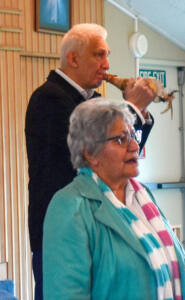
WelCom November 2023
Carolyn Tait
Ōtari Parish of Wellington has been slowly integrating more te reo Māori into our Mass responses for some years.
Around 8.30am on Sunday 8 October, the sound of taonga puoro (traditional Māori instruments) echoed over Wilton’s valley from St Thomas More Church. The pūtātara, conch shell, signalled the opening of Miha Māori with Ōtari and Te Ngākau Tapu parishes for the 27th Sunday in Ordinary Time.
Pā Gerard Burns parish priest of Te Ngākau Tapu and Fr Ron Bennett parish priest of Ōtari concelebrated. Māori and English were woven through the Mass – in the languages, music, and in the tikanga.
Matiu White gave a bilingual greeting/mihi. Henare Walmsley’s (Katekita Māori) taonga pūoro and the St Thomas More music group lifted us with their sounds. Helen Fisher’s Te Miha Tuituia Mass sung responses provided a familiar bridge across cultures. The call of Whaea Kataraina Millin, as Kaikaranga, during the Consecration provided special moments.
Pā Gerard’s homily was about the idea of relationships within covenants. He said we bring a history of covenants from the First Testament when we gather to worship, and that in Aotearoa, we also have a covenant with the first peoples of New Zealand with Te Tiriti o Waitangi.
Pā Gerard explained how a covenant looks towards the future as a living relationship full of possibilities and hope. He said Te Tiriti was founded on the 1835 Declaration of Independence, as providing a way for establishing relationships between new settlers and first peoples. He described how the terminology used in the two versions of the Treaty – te reo Māori and English – conveyed different understandings. The Waitangi Tribunal has explored our histories since the Treaty signing, to provide a basis for better relationships between Tangata whenua and Tangata Tiriti. Pā Gerard said Te Tiriti can be seen as a covenant that provides possibilities for growth and hope.
After Miha we shared kai. Relationships were nurtured and new ones formed as Ōtari Parish continues its journey of understanding our role with this land and its people.
Carolyn Tait on behalf of the Ōtari Parish Justice, Peace and Development group.